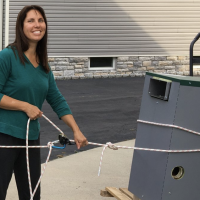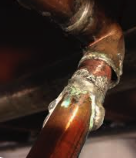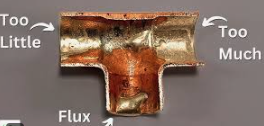DIY result, will it hold?
Hi all,
My apartment's main shut off valves for both hot and cold failed. I opt to do the job myself. It is of the solder on type.
Being new to soldering pipes I practiced a few rounds before I actually did the replacement.
The new shut off valves are Apollo 1/2", I followed all directions such as cleaned the pipe ends and used tinning flux with low temp solder.
I aimed the torch blowing down and pointed away from the ball valve. The solder was placed at the bottom of the pipe and sucked up by the heat via capillary action. However I noticed that one of the end where the space is very confined the solder job looks poor. Please see attached. So far it has not leaked and is holding. In your opinion do you think it will leak or fail in the future? Thank you all in advance.
Comments
-
Hard to say, if what you see is the only issue and the other 98% of the joint is good it will probably last. I find the cleaning prep helps the most, get it all super clean, I even clean the 1/8" wide edge part of the larger female part so the solder flows to it too.
National - U.S. Gas Boiler 45+ Years Old
Steam 300 SQ. FT. - EDR 347
One Pipe System1 -
can't tell. if that is the only void it is just cosmetic. if it didn't wet inside the joint it may leak. if it wetted right there should be solder in 90% of the length of the socket and it isn't an issue
0 -
-
Should have used Sharkbite!
NJ Steam Homeowner.
Free NJ and remote steam advice: https://heatinghelp.com/find-a-contractor/detail/new-jersey-steam-help/
See my sight glass boiler videos: https://bit.ly/3sZW1el3 -
Only way to know is cut it apart and hammer the two pieces apart. The heat application has a lot to do with how the solder draws into the socket. Water soluble flux and no lead solder are a bit tricky to work with. Easy to burn the connection black then solder will not pull in. Sounds like yours pulled in some solder?
"Capping off" is a term sometimes used to describe putting a bead around the end of a joint. But it shouldn't be dependent on to seal the joint, more for cosmetics on loose fittings.
A true pro would have caught that drip and cleaned it off :)
Bottom line, does it leak?
Bob "hot rod" Rohr
trainer for Caleffi NA
Living the hydronic dream1 -
I agree: Excellent work for your first time and you didn’t burn the place down.
I wouldn’t worry about that gap in the solder; it happens.
Soldering was easier when lead was OK to use in the solder and also in the fittings. Lead Free is more finicky.8.33 lbs./gal. x 60 min./hr. x 20°ΔT = 10,000 BTU's/hour
Two btu per sq ft for degree difference for a slab1 -
different alloys also flow better than others. the box stores mostly have the ones that are cheap, not the ones that flow well.
0 -
What's the best in your experience?
0 -
Bridgit is a really good solder with a low melt point and wide workability temperature range. Very similar to 50/50. 50/50 is still available, use it on hydronic work.
As the name suggests, it is good for capping and loose fittings. Home Depots around me carry it
Bob "hot rod" Rohr
trainer for Caleffi NA
Living the hydronic dream0 -
-
It doesnt "look" great, but if it hasn't leaked yet, you'll probably be OK. Mad Dog
0 -
-
Wiping the remaining flux off after soldering shows that you care about your work. Not doing so can cause deterioration of the pipe from aggressive chemicals in the flux. I believe it was La-Co that used to claim "self-cleaning".
8.33 lbs./gal. x 60 min./hr. x 20°ΔT = 10,000 BTU's/hour
Two btu per sq ft for degree difference for a slab1 -
My apology for not updating sooner. It has been rough lately. Thank you for the kind words and here is where things are now.
To date, the solder joints are dry. If a few months has gone by and everything seems fine, what are the chances down the road it might leak in your experiences? Let's say if someone opens up a closed main water valve to the whole building too fast? Will these joints to my apartment unit's valve hold? Finally does tinning flux (Oatey #95) really help newbies like me to make the process foolproof?
I can't get a phone in there to film so I bough a small borescope. The resolution isn't great but perhaps the video can provide some additional details. It can be found here:
https://u.pcloud.link/publink/show?code=XZB6Vf5Zc71MzOFIh4y8uncSFjR5Gkezqg77
I did put extra time into preping, clean and de-burr the joints. However, I did not sand and polish the solder after the job is finished. Don't know how much of impact that will be. I did however wipe off the extra flux on the pipes.
The solder and flux I used are:
https://www.homedepot.com/p/Worthington-16-oz-Sterling-Premium-Solder-333532/203525002
https://www.homedepot.com/p/Oatey-8-oz-Lead-Free-Water-Soluble-Solder-Tinning-Flux-30142/100127686For those of you who are interested of the background. This is my apartment unit in NYC. When I discovered the old hot and cold main valves no longer worked, I called around to a few plumbing companies and all of them stated they do not solder, which I found very odd. They either want to replace the valve either with compression fittings or press fittings. That is when I decided to do this job myself.
I read and watched videos from multiple valve manufacturer and home improvement videos. I ended up using L copper pipes and used a fireproof blanket behind the area that I am working on.
Two of the most helpful videos are:
https://www.youtube.com/watch?v=cELzc9ZophQ
https://www.youtube.com/watch?v=A3cuXXQTk2oI was very interested in hiring one of the local plumber that does in person tutoring just to be on the safe side. However he declined due to distance, and Facetime was not an option for him.
The one issue that I had was with replacing the kitchen faucet valves. (yeah I know, I really rolled the dices for my first time) Doesn't matter how long I heat the valves the solder simply does not melt correctly. After further research, I found that I had residue water left in the pipes. So I opened all water fixtures, drained as much as possible, and then shoved a rolled up piece of white bread ball into the pipe. After that, the kitchen valves went on as expected.
The LOL moment: with the main cold water valve of my apartment shut, the toilet tank still fills after a flush. Turns out the toilet is piped before the main cold water valve. There is another gate valve in front of it that allows shut off the toilet valve, but does not stop the cold water for the rest of the apartment. I think it might be this guy that did the initial piping:
https://www.youtube.com/watch?v=OP30okjpCkoAs always, thank you with the uttermost appreciation.
1 -
-
This could have to do with the Hot Work Permit being required to work in that building?
Copper press connections are a safe, reliable method for that type of work.
The only way to know the quality of a soldered joint is to cut it open. That is what is required when you take a plumbing license test in some jurisdictions. Same for a poured lead joint test.
The type and brand of solder and flux is more a personal choice, like a tool or truck :)
The appearance of the joint can sometimes tell if the solder work was successful. In rare cases the joint can develop a leak after some use if a flux pocket washes out, for example. Many a plumber has had a sweat joint leak appear days later.
With experience you can tell or feel if the joint flowed the appropriate amount of solder into the fitting successfully.
Bob "hot rod" Rohr
trainer for Caleffi NA
Living the hydronic dream1 -
I’m a “too much” guy! 😂
0 -
the tinning flux makes the surface of the joint tin as soon as it gets hot enough to melt the solder. that makes it harder to burn out the flux by heating part of the joint hot enough to burn the flux before you flow solder in to it. the higher melting point of lea free solder means that the point at which the solder melts and the flux burns is much closer than for tin-lead solder. If the whole joint wasn't heated enough or water was dripping in to part of it there can be a portion of the joint that didn't get solder in it with a thin cap or solder at the end of the fitting. those can develop a small leak over time.
0 -
-
Categories
- All Categories
- 87.4K THE MAIN WALL
- 3.2K A-C, Heat Pumps & Refrigeration
- 61 Biomass
- 429 Carbon Monoxide Awareness
- 120 Chimneys & Flues
- 2.1K Domestic Hot Water
- 5.8K Gas Heating
- 115 Geothermal
- 168 Indoor-Air Quality
- 3.7K Oil Heating
- 77 Pipe Deterioration
- 1K Plumbing
- 6.5K Radiant Heating
- 395 Solar
- 15.7K Strictly Steam
- 3.4K Thermostats and Controls
- 56 Water Quality
- 51 Industry Classes
- 50 Job Opportunities
- 18 Recall Announcements
















